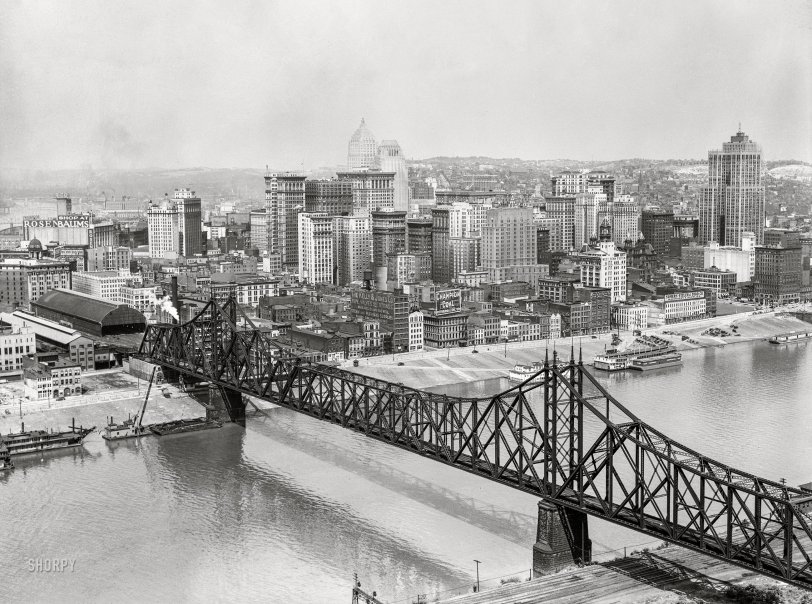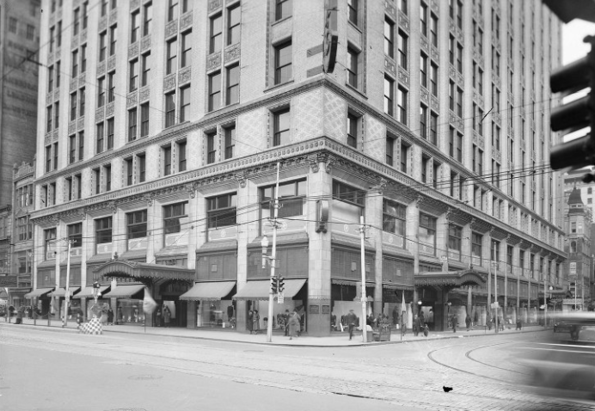


Framed or unframed, desk size to sofa size, printed by us in Arizona and Alabama since 2007. Explore now.
Shorpy is funded by you. Patreon contributors get an ad-free experience.
Learn more.

- Lofty addition
- In 1912
- Keenan Building
- Six years old
- Taken from the P.J. McArdle Roadway?
- It stood only 47 years
- Three track mind
- Incline to the right
- Reach for the sky, 1912 style
- No clean sweep
- Same Job Title, Same Face
- Sadly Lost
- Beautiful ...
- Where you get your kicks
- Aim High
- Pueblo Revival sisters
- Pueblo Neoclassicism
- Milk Man
- Regional dialect.
- Spielberg's inspiration
- Great Photo
- Loaf Story
- Do you still have the Rakes category?
- Could almost be a scene from the 1957 movie 'Hell Drivers'
- The Wages of Fear.
- Conspicuous by their absence
- Got Milk?
- All that aluminum
- No lefties
- Smoke 'em if you've got 'em
Print Emporium
Steel City: 1938

July 1938. "View of city of Pittsburgh, Pennsylvania." The Wabash Bridge over the Monongahela River. Medium format acetate negative by Arthur Rothstein. View full size.
Some things never change
The Pittsburgh waterfront changed significantly after the war with the addition of the feeder expressways (The Parkway East and West), as well as the removal of any industrial remnants during the "Renaissance". But at least one block of buildings on Fort Pitt Boulevard is almost completely intact. The building with the Champion Coal sign is gone and is now a surface lot. But the rest of the buildings in that block between Market and Wood are all still standing.
And the fairly large building at the corner of Smithfield and Fort Pitt is still there (dark building at the extreme left). But the masonry has been completely cleaned and the architectural highlights are actually light stone. The Smoky City really did wreak havoc with the furnishings.
Wabash Pittsburgh Terminal
The Wabash terminal is the long, dark bar like building to the left of the bridge -- that’s the trainshed, and the adjoining building with the cupola was the headhouse of the station. It was unusual (but not unique) for a station that size, in that the tracks were on the second story. Out of the picture to the left was a small elevated freight terminal, which some sources suggest was originally meant to carry the railroad across the city, to a never-built route to link George Gould’s projected transcontinental system with the New Jersey port cities.
Lee Kee car park
It's easy to see how the vehicle parking was arranged on the Mon wharf. Drips and dribbles from countless crankcases, transmissions and differentials have left their mark. This is also seen on the concrete highways up to the present.
When I started riding motorcycles in the early seventies my father warned me not
to ride the middle of a lane when it first started to rain. Slippery as hell he said. He had been a motorcycle MP during WW2 and knew of what he spoke.
Gone But Not Forgotten
The Wabash bridge and terminal just at the end of the bridge were part of Jay Gould’s Alphabet Route railway in the early 1900s.
After two fires in the terminal in 1946, this line was abandoned and the bridge was torn down in 1948. The bridge piers still stand and the Wabash’s connecting tunnel under adjacent Mount Washington is now a high-occupancy vehicle route into Pittsburgh.
https://en.m.wikipedia.org/wiki/Pittsburgh_and_West_Virginia_Railway
Troubled Bridge Over Waters
The bridge was built from both banks, but the merger failed and the center of the bridge collapsed. Ten workers died. Construction was also plagued by smallpox, bad weather, and strikes. The bridge was completed in 1904, but its owner, the Wabash railway line, fell into receivership in 1908. By 1931, the bridge was used only for freight traffic through the downtown terminal. When the terminal burned in 1946, the bridge became useless. It was demolished in 1948.
The car parking looks very scary.
The car parking looks very scary. It stands at big angle.
Rosenbaum's Department Store
I see so many interesting signs: The Kelly & Jones Co. (Pipes, Valves and Fittings), Champion Coal, Somers-Fitler & Todd Co. (Machinery & Supplies). But the one that really caught my eye was the biggest: Shop at Rosenbaum's. Corner of Liberty and Sixth, photo taken in 1937.

























On Shorpy:
Today’s Top 5